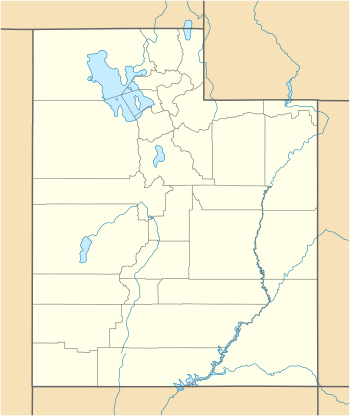Bechan Cave
Bechan Cave is a single-room sandstone rock shelter located at an elevation of 1,280 metres (4,200 ft) along Bowns Canyon Creek, a tributary of the Glen Canyon segment of the Colorado River, in Kane County in southeastern Utah in the United States.[1][2] The cave is roughly 31 metres (100 ft) wide, 9 metres (30 ft) high and 52 metres (170 ft) deep.[3][4] It has a single entrance that faces southwest[1] and is well-lit during the daytime.[3]
| Bechan Cave | |
|---|---|
 | |
| Location | Kane County, Utah, United States |
| Coordinates | 37°22′33.16″N 110°52′33.96″W |
| Elevation | 1,280 metres (4,200 ft) |
| Geology | Sandstone |
| Entrances | 1 |
The cave holds alluvial deposits containing the remains of Pleistocene megafauna,[2] including mammoths,[4] ground sloths, and even-toed ungulates.[5] Archaeological excavation of the site in 1983 and 1984 by paleontologists Larry Agenboard and Jim Mead[6] unearthed animal bones, dung, hair, and teeth dating from 11,555 BCE to 9720 BCE, underneath "a few feet"[7] of cave fill, consisting of ceiling spall and wind-blown sand,[3] containing evidence of Holocene habitation from the Archaic period to the Basketmaker culture and possibly even by Navajo or Paiute.[1] Among the items unearthed were large dung boluses, similar in size to the dung of the African elephant, containing the stems of graminoids[5] and sedge (Carex).[8] The cave is also one of at least seventeen sites on the Colorado Plateau where Archaic-era Southwestern sandals have been discovered.[9]
The cave's name derives from a Navajo word meaning "big dung"[7] or "big feces".[4][10] The well-preserved dung layer was deposited over approximately 1,000 years by multiple animal species during a period characterized by the proliferation of oak and the decline of blue spruce and water birch.[5] The organic deposit consists primarily of Columbian mammoth (M. columbi) dung but also includes dung belonging to shrub-oxen (E. collinum), Shasta ground sloths (N. shastensis), Harrington's mountain goats (O. harringtoni), bighorn sheep (O. canadensis), cottontail rabbits, pack rats, and possibly equines.[3] With a thickness ranging between 4 and 16 inches (10–41 cm),[7] an area of more than 300 square metres (3,000 sq ft),[10] and a volume of 225 cubic metres (8,000 cu ft),[5][11] it is the largest coprolite deposit in North America.[4] Other macrofossils discovered in Bechan Cave include teeth and a bone, a "metapodial condyle", belonging to E. collinum.[12]
The cave is located inside Glen Canyon National Recreation Area[13] and, though it is rarely visited, is accessible on foot from Bowns Canyon.[14] The 5-mile (8.0 km) round-trip hike between Bowns Canyon, which can be reached from Lake Powell by boat, and Bechan Cave is considered moderately difficult.[14]
References
- Agenbroad, Larry D.; Mead, Jim I.; Mead, Emilee M.; Elder, Diana (1989). "Archaeology, Alluvium, and Cave Stratigraphy: The Record from Bechan Cave, Utah". Kiva. 54 (4): 335–351. doi:10.1080/00231940.1989.11758126. JSTOR 30247207.
- "Utah Segments". National Park Service. June 17, 2004. Archived from the original on August 7, 2016. Retrieved August 7, 2016.
- Mead, Jim I.; Agenbroad, Larry D. (1992). "Isotope dating of Pleistocene dung deposits from the Colorado Plateau, Arizona and Utah". Radiocarbon. 34 (1): 1–19. doi:10.1017/S0033822200013370. Retrieved October 31, 2016.
- Agenbroad, Larry D.; Nelson, Lisa W. (2002). Mammoths: Ice-Age Giants. Minneapolis: Lerner Publications Company. p. 61. ISBN 978-0-8225-2862-3.
bechan cave.
- Agenbroad, Larry D.; Davis, Owen K.; Martin, Paul S.; Mead, Jim I. (1984). "The Pleistocene dung blanket of Bechan Cave, Utah". In Genoways, H.H.; Dawson, M.R. (eds.). Contributions in Quaternary vertebrate paleontology: a volume in memorial to John E. Guilday. Special Publications of Carnegie Museum. S008. Carnegie Museum of Natural History. pp. 267–282 – via the National Park Service (see p. 35).
- Hitchcock, Don (August 17, 2011). "Mammoth and Bison rock engravings in Utah". Don's Maps. Archived from the original on March 13, 2016. Retrieved August 21, 2016.
- Hoffecker, Lilian T. (January 1999). "Droppings of Mammoth Proportions". Highlights. pp. 40–41. Archived from the original on July 29, 2010. Retrieved August 14, 2016.
- Agenbroad, Larry D.; Mead, Jim I. (1995) [First published 1989 in Geology]. "Quaternary geochronology and distribution of Mammuthus on the Colorado Plateau". In Boaz, D.; Bolander, S.; Dierking, P.; Dorland, M.; Tegowski, B.J. (eds.). Proceedings of the Third Annual Fossils of Arizona Symposium, November 18, 1995. Mesa Southwest Museum. p. 109. ISBN 978-0-935810-61-5.
- Teague, Lynn Shuler; Washburn, Dorothy Koster (2013). Sandals of the Basketmaker and Pueblo Peoples: Fabric Structure and Color Symmetry. Albuquerque: University of New Mexico Press. pp. 3–4. ISBN 978-0-8263-5331-3.
- Mayor, Adrienne (2007). "Place names describing fossils in oral traditions". Geological Society, London, Special Publications. 273: 245–61. CiteSeerX 10.1.1.503.7503. doi:10.1144/GSL.SP.2007.273.01.19.
- "What Can We Learn from Fossil Dung?". Children's Discovery Museum of San Jose. Archived from the original on August 16, 2016. Retrieved August 16, 2016.
- Kropf, Manny; Mead, Jim I.; Anderson, R. Scott (January 2007). "Dung, diet, and the paleoenvironment of the extinct shrub-ox (Euceratherium collinum) on the Colorado Plateau, USA". Quaternary Research. 67 (1): 143–151. doi:10.1016/j.yqres.2006.10.002.
- Santucci, Vincent L.; McClelland, Lindsay, eds. (September 2001). Proceedings of the 6th Fossil Resource Conference (PDF). Conference on Fossil Resources. National Park Service. Retrieved August 15, 2016.
- "Bechan Cave". Intermountain Healthcare. Retrieved August 15, 2016.
External links
- 42KA2546 (Bechan Cave) at the Canadian Archaeological Radiocarbon Database
- Photographs of Bowns Canyon (including Bechan Cave) at Backcountry Post